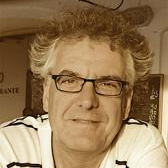Buenos dias! This is an update from the last day of presentations, tomorrow there will be a field excursion to the Patzcuaro area (1858 eq event). Unfortunately Christoph and I cannot join the field trip, because we booked already our flights for Friday. But we will keep you informed. Are you wondering what the title photo is?
It is the prehispanic description for earthquake, I received the statue as a gift from the organizers. In the photo below you can see the interpretation of the symbol. However, there is more if the center eye is open, the eq occurred at day time, is it filled at night. The carved rays even give the direction from which the seismic waves came (in my statue carvings are trending N30W). Fascinating!
Today the sessions were filled with more interesting talks in the morning, followed by a guided poster session. The afternoon session was dedicated to training lectures on social media and on how to use the EEE catalogue. The INQUA vice-president Franck Audemard, TERPRO president Alessandro Michetti and Focus Group president Pablo G. Silva thanked very much the organizer of the meeting Victor Hugo Garduño (Morelia, Mexico) and his marvellous team for the hospitality in Morelia.
Morning session
Carlos Costa (Argentina) presented in his key note lecture the efforts of the neotectonic data base of South America, and focussed later mainly on reverse faulting in South America and the problems arising with empirical relationships and observed surface rupture length and displacement, especially on low-slip rate faults, poorly preserved faults and fault-related folds. Finally, he stressed the confusion existing of what is an „active“ fault and which is the definition for it. Another interesting point is the estimation of the „threshold earthquake“ to constrain a minimum EQ size. The lifely discussion after the talk clearly showed the need for saying „farewell“ to the term „active“ and replace it by „capable“ in future to avoid confusion regarding the regional seismic hazard assessment. The terminology is currently reviewed and improved by a split team of several members of our group.
Jin-Hyuck Choi (South Korea) talked about his very interesting research on slip compensation and structural maturity of linked fault systems with the example of the Bogd rupture associated with the 1957 Gobi-Altay earthquake in Mongolia.
Business meeting of the INQUA Focus Group on Active Tectonics and Paleoseismology, discussion on the upcoming meetings: the 4th meeting will be in Aachen, Germany in October 2013 (11.-13.), the 5th meeting later will be in Busan, South Corea (in May or September), and the 6th meeting will be held 2015 in Fucino (April or May) in Italy, in order to remember the centenial of the Fucino eq in 1915. Finally, this INQUA intercongress period will be terminated by the XIX. INQUA meeting in Nagoya, Japan in summer 2015 (link).
Afternoon session
The afternoon session started with a presentation of geological and paleoseismicity information according to means of web 2.0. Christoph enthusiastically showed several examples of web pages, blogs, data repositories and geo-information in the internet. A fascinating news is that EQ twitters are faster travelling and spreading than EQ waves as demonstrated during the Virginia EQ last year (link). We hope he will give us a review and concentrated summary here on paleoseismicity.org!
Then, Luca Guerreri (Italy) introduced the auditorium into the EEE catalogue (environmental earthquake effects database), which has been endorsed at global level by an INQUA TERPRO Project and based at ISPRA in Italy (link). Everybody can be a data compliler after registration and log-in. With the help of the database the most vulnerable and most affected zones can be mapped after an earthquake with a side-individual assessment of the ESI scale (link).
In the evening lecture Gerardo Suarez showed nicely the paleoseismicity of the Transmexican Volcanic Belt with 5 large and deadly earthquake events in the last 150 years. He pointed out that the causative faults with the exception of the Acambay 1912 event are not known. And furthermore, these earthquake occurred in Mexico´s densely populated area stretching West of Mexico City. Also, in this area, many critical faciliites, like reservoir dams and nuclear power plants are situated. At the end, Gerardo close the workshop officially, and thanked again our hosts in Morelia. Thank you, Gerardo, also from us here, and we will meet in Aachen in 2013. As a closing act, a band from Morelia played some nice Mexican and Michaocan titles in the cultural hall of Morelia University.





No Comments
No comments yet.